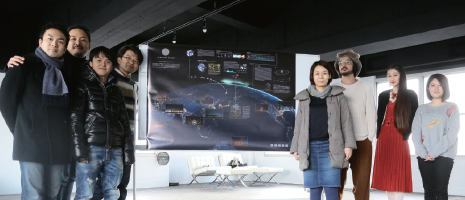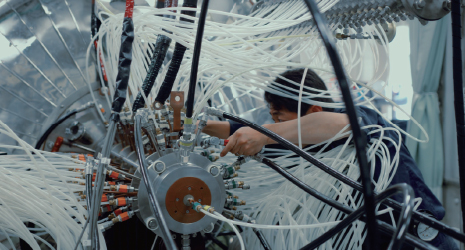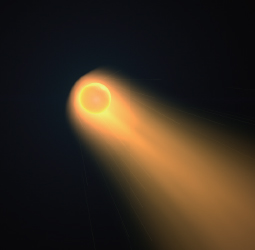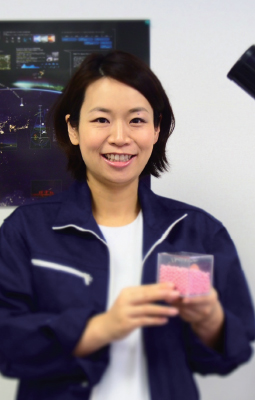Home > Highlighting JAPAN >Highlighting Japan February 2016>Women in the Lead
Highlighting JAPAN


The Cosmos Is Our Canvas
Lena Okajima and her company ALE Co., Ltd. are blending science, art and entertainment in their artificial shooting star project, aiming to create truly stellar entertainment in outer space.
Imagine seeing an array of vividly colored shooting stars streaking across the night sky—a manmade meteor shower created here on Earth and delivered via satellite to enthrall audiences on the planet’s surface. This is the brainchild of Lena Okajima, who holds a doctorate in astronomy from the University of Tokyo. She and her team at ALE Co., Ltd. are working to realize Okajima’s dream of launching artificial shooting stars in the stratosphere, and someday even beyond that.
“Seeing a shooting star is an amazing experience,” Okajima says. “A person is lucky to see two shooting stars coming in sight at the same time. I’ve always dreamed of seeing them coming down like a rain shower.” In 2011, she gathered people with a similar vision together to form ALE.
Interested in science from a young age, Okajima become captivated by outer space during junior high school when she learned about black holes, the creation of the universe and the Big Bang theory. While dedicating herself to studying astronomy at the University of Tokyo, Okajima discovered that Japan was investing large amounts of public funds in scientific research and equipment dedicated to outer space.
Okajima, however, had another aspect of space exploration in mind. Her approach focuses on connecting everyday people with astronomy and the sciences, using the manufacture of artificial shooting stars as the basis of a commercial enterprise. “People often think astronomy is not a useful science, but I think it can be used to encourage people to find enjoyment in outer space while also supporting scientific research,” Okajima notes.
ALE has completed roughly half of the necessary research into making its shooting stars. Working with professors and researchers from various universities, the team has already created shooting-star-source spheres, and has now started developing a cube-shaped satellite roughly fifty centimeters in diameter that holds about a thousand of these small spheres. The spheres will be ejected from a satellite, burning brightly as they enter the earth’s atmosphere. The composition of each sphere can be altered to produce a range of different hues, and there is no virtually no environmental impact, since the spheres burn up completely in the process.
“Naturally occurring shooting stars can only be seen for under a second,” Okajima adds, “but ours can be seen for about two to three seconds. They can also be viewed from a range of two hundred kilometers.” That’s about four hundred times the area in which conventional fireworks are visible.
Now that the research behind making these artificial meteors is moving toward its final stage, Okajima is focusing on the aesthetic aspect behind the spectacle. She’s working with various artists to plan a time and place for people to wish upon her shooting stars. Under the project name Sky Canvas, scientists and artists have come together to share their ideas.
“In many projects, having too many people with too many different ideas can be a problem,” Okajima says. “With Sky Canvas, though, more is better. The ideas may be diverse, but everyone is working toward the same goal.” The proposals so far include local promotions like Light Up Nippon, which supports the Tohoku region, as well as larger international events such as the torch-lighting ceremony of the 2020 Tokyo Olympics. And with the night sky as the canvas, there are undoubtedly many opportunities waiting outside of Japan. “We have always thought of the world as our customer,” Okajima says.
If things go according to schedule, ALE’s manmade meteors should be lighting up the cosmos by the end of 2017 or early 2018. Meanwhile, the company will develop a prototype, reserve space on a rocket, and expand its support base through promotion. When asked about future projects, Okajima insists that Earth’s low orbit is only a first step. “With space entertainment, I want to go farther and deeper into outer space.”
© 2009 Cabinet Office, Government of Japan








